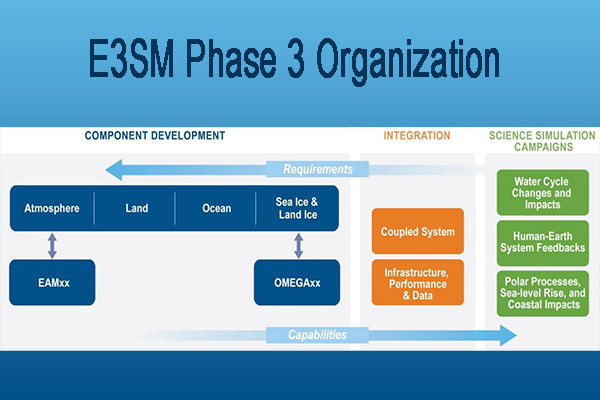Phase 3 (2023 – )
The E3SM project is a DOE BER Science Focus Area (SFA) project and as such is funded for a 3-year period after a successful proposal. The project refers to each funding period ‘an E3SM Phase’. Phase 2 of the project ended at the end of 2022, and Phase 3 of the project started at the beginning of 2023.
A New E3SM Alignment
The E3SM project’s functional organization is realigning to better address the Nation’s strategic challenges. This new organization was presented in a recent review to the Department of Energy’s (DOE) Biological and Environmental Research (BER) program. This new alignment refocuses the project on actionable projections to achieve its long-term goal of producing actionable science simulation with a state-of-the-art Earth system model executing on Office of Science Exascale Computing systems.
Phase 3 Project Structure
To align the science drivers more explicitly with the goal of actionable modeling and projections of Earth system variability and change, while maintaining the foundational science on which they depend, the project has redefined the new drivers as: (1) Water Cycle Changes and Impacts; (2) Human-Earth System Feedbacks; and (3) Polar Processes, Sea Level Rise, and Coastal Impacts. These new, more explicit drivers highlight specific aspects of the Earth system that connect the E3SM model development and simulation campaigns to challenges facing our Nation and DOE.
To better align and refocus the project with these science drivers, the science simulation campaign groups were renamed. The Water Cycle group will more accurately be now named “Water Cycle Changes and Impacts”, the BGC group focusing on human-earth interactions will be now called “Human-Earth System Feedbacks” and the Cryosphere will refocus as “Polar Processes, Sea-Level Rise and Coastal Impacts”.
The project’s organization is further maturing to support parallel tracks to develop and release E3SM version v3 in 2023 and v4 in 2026. The project evolved to operate in this mode during Phase 2, with significant overlap between the Science groups, responsible for model integration, simulation execution, and analysis, and the Next-Generation Development subprojects, organized mostly around components. As shown in Figure 1 there will be ten groups in Phase 3, the same number as in Phase 2. The atmosphere component has two tightly coupled groups to provide overlap and continuity between the current and near-term component code versions (Atmosphere-EAMv3) and the longer-term, refactored performance portable versions (EAMxx) designed for Exascale machines. The Ocean component group will focus on the improvements to the MPAS-Ocean model (for E3SM v3) as well as on the development of a new, C++ and YAKL based performance portable, Ocean Model for E3SM Global Applications (OMEGA). This group will be named Omega.
The responsibility for the core model integration and tuning was separated from the Phase 2 Water Cycle group to create the Coupled System group. Its role will be to integrate the components for each new full model release and perform the evaluation simulations defined in the DECK (Diagnostic, Evaluation, and Characterization of Klima) and CMIP historical simulations (1850 – near-present) protocols. Science Simulation groups will concentrate on executing, analyzing, and publishing results from the simulation campaigns to address science questions.
The Infrastructure group will become the Infrastructure, Performance, and Data group, and its members will have the responsibilities for maintaining and extending the project’s software system, associated scripts, analysis software, and management, as well as curation and distribution of production simulation output. They will test and apply optimal, machine-specific configurations for the simulation campaigns and solve problems associated with changes in the software stacks (compilers, libraries, I/O systems, etc.) at the Office of Science computing centers. The Machine Learning/Artificial Intelligence (ML/AI) Coordinator will provide a forum to share experiences among the ML/AI Epics in the project as well as serve as the project’s ML/AI external representative. Similarly, there is a cross-cutting Performance Coordinator to coordinate the performance effort across all groups.
Lastly, the Executive Committee (Exec), comprised of the Council Chair (CC, and project Principal Investigator), the Chief Scientist (CS), the Chief Computational Scientist (CCS), and the Project Engineer (PE) / Chief Operating Officer (COO), selected by the Program Manager in consultation with the DOE Earth and Environmental Systems Sciences Division Director, are not changing.
E3SM Leadership Team
See The Leadership Team for details of the organizational structure.



